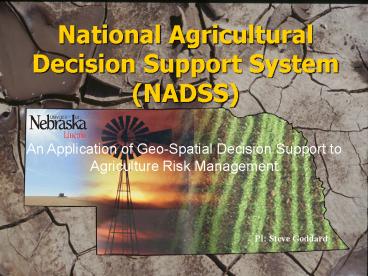National Agricultural Decision Support System (NADSS) - PowerPoint PPT Presentation
Title:
National Agricultural Decision Support System (NADSS)
Description:
... and decrease the risk of drought stress. ... Drought Indices Soil Data Climate Data Reported Yields Raster interpolation of data points within various ... – PowerPoint PPT presentation
Number of Views:70
Avg rating:3.0/5.0
Title: National Agricultural Decision Support System (NADSS)
1
National Agricultural Decision Support System
(NADSS)
An Application of Geo-Spatial Decision Support to
Agriculture Risk Management
PI Steve Goddard
2
What is NADSS?
- The National Agricultural Decision Support System
(NADSS) is a distributed web-based application to
help decision makers assess various risk factors - our research has focused primarily on drought
- we are investigating ways to use the system to
create tools to aide in the identification of
risk areas - Using various data and computational indices we
are able to create tabular data for analysis as
well as maps for further spatial analysis
3
The Partnership
- National Science Foundations Digital Government
Program - National Drought Mitigation Center, University of
Nebraska--Lincoln - High Plains Regional Climate Center, UNL
- USDA Risk Management Agency, Natural Resources
Conservation Service, National Agricultural
Statistics Service, and the Farm Service Agency - USGS EROS Data Center
- Nebraska Research Initiative on Geospatial
Decision Support Systems - GIS Workshop
4
Funding
- Source NSF 1 Million, 7/011/05
- Title DIGITAL GOVERNMENT A Geospatial Decision
Support System for Drought Risk Management - Principal Investigators Steve Goddard, Jitender
Deogun, Michael J. Hayes, Kenneth G. Hubbard,
Stephen Reichenbach, Peter Revesz, W.J. Waltman,
Donald A. Wilhite, and Mark D. Svoboda,
University of Nebraska-Lincoln (UNL), Lincoln,
Nebraska 68588-0115. (goddard_at_cse.unl.edu) - Co-Investigators Sheri K. Harms, University of
Nebraska-Kearney J.S. Peake, University of
Nebraska-Omaha Ray Sinclair and Sharon Waltman,
USDA Natural Resources Conservation Service,
National Soil Survey Center, Lincoln, NE and
Marcus Tooze, GIS Workshop, Lincoln, NE.
5
Funding
- Source USDA RMA/FCIC 1.3 Million, 10/023/05
- Title RISK ASSESSMENT AND EXPOSURE ANALYSIS ON
THE AGRICULTURAL LANDSCAPE A Holistic Approach
to Spatio-Temporal Models and Tools for
Agricultural Risk Assessment and Exposure
Analysis - Principal Investigators Steve Goddard, Jitender
Deogun, Michael J. Hayes, Kenneth G. Hubbard, H.
Douglas Jose, Stephen Reichenbach, W.J. Waltman,
Donald A. Wilhite, and Mark D. Svoboda,
University of Nebraska-Lincoln (UNL), Lincoln,
Nebraska 68588-0115. (goddard_at_cse.unl.edu) - Co-Investigators Norman Bliss, EROS Data
Center Sioux Falls, SD Sheri K. Harms,
University of Nebraska-Kearney and J.S. Peake,
University of Nebraska-Omaha Ray Sinclair and
Sharon Waltman, USDA Natural Resources
Conservation Service, National Soil Survey
Center, Lincoln, NE and Marcus Tooze, GIS
Workshop, Lincoln, NE.
6
NADSS Web Site
- http//nadss.unl.edu/
7
Current Tools
- Our current tools apply risk analysis
methodologies to the study of drought - Integration of basic models with data generates
information for analysis by decision makers - Information can be gathered at any resolution for
which we have data - http//nadss.unl.edu
8
Current NADSS Tools
9
Current NADSS Tools
Planting date guide tool with date sliders,
numerical information, and navigation
buttons. Sample risk analysis maps of growing
non-irrigated corn in NE and Custer county.
10
Proposed NADSS Tools
An Irrigation Scheduling tool that will help
producers better manage their limited water
resources, decrease the use of energy for
pumping, and decrease the risk of drought stress.
11
Another Proposed NADSS Tool
A Crop-Specific Yield Prediction tool that will
provide the producer with an estimate of yield
based on the weather up to the current date and
projections of what it might be from the current
date to the end of the growing season.
12
Another Proposed NADSS Tool
A Field Analyst tool that can, for example,
analyze the soil quality for a particular field
based on the NRCS Soil Rating for Plant Growth
(SRPG) index. It can also be used by a
producer to evaluate value added when new
fields are put into service or removed from
service.
13
Another Proposed NADSS Tool Field Analyst
continued
Following the example using an SRPG analysis,
when both an original field and field addition
have been digitized, the Field Analyst provides
the user with the SRPG of the combined fields,
and whether the field addition had a positive or
negative affect on the overall soil quality.
14
Building a Spatial View
- Data from information and knowledge layers are
translated spatially and interpolated to provide
a risk view for a defined area
Re-summarization of raster data Generation of
displayable images
Drought Indices
Soil Data
Climate Data
Reported Yields
Other Data Type
15
Combining Risk Factors
- By combining several domain specific factors from
our information layer we are able to create
maps displaying the risk for states, regions or
countries
Variables are spatially rendered
The user adjusts weight factors for each variable
The result is a spatial view of risk
16
Conclusion
- We have developed the framework for a Distributed
Geospatial Decision Support System architecture
that can be applied to other problems and domains - For example, we can integrate water models,
economic models and even threat models into the
system.
17
Application Layer (user interface) e.g. Web
interface, EJB, servlets
Knowledge Layer e.g. Data Mining, Exposure
Analysis, Risk Assessment
Information Layer e.g. Drought Indices, Regional
Crop Losses
Data Layer e.g. Climate Variables, Agriculture
Statistics
- Any component can communication with components
in other layers above or below it - Each layer is tied to the spatial layer, allowing
the data from any layer to be rendered spatially
Spatial Layer e.g. spatial analysis and rendering
tools

